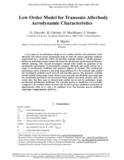JavaScript is disabled for your browser. Some features of this site may not work without it.
| dc.contributor.author | Zuccolo, Giovanni | |
| dc.contributor.author | Christie, Robert | |
| dc.contributor.author | MacManus, David G. | |
| dc.contributor.author | Goulos, Ioannis | |
| dc.contributor.author | Martin, Peter | |
| dc.date.accessioned | 2020-02-03T12:27:44Z | |
| dc.date.available | 2020-02-03T12:27:44Z | |
| dc.date.issued | 2020-01-05 | |
| dc.identifier.citation | Zuccolo G, MacManus D, Christie R, et al., (2020) Low order models for transonic afterbody aerodynamic characteristics. In: 2020 AIAA SciTech Forum, 6-10 January 2020, Orlando, Florida, USA. Paper number AIAA 2020-1997 | en_UK |
| dc.identifier.uri | https://doi.org/10.2514/6.2020-1997 | |
| dc.identifier.uri | https://dspace.lib.cranfield.ac.uk/handle/1826/15070 | |
| dc.description.abstract | A key aspect in the preliminary design of new combat aircraft is the prediction of the afterbody and exhaust system aerodynamic drag. To meet the various operating conditions requirements for a multi-role vehicle the afterbody typically includes a variable geometry. Within the preliminary design context, this makes the aerodynamic performance prediction a difficult challenge. This research investigates reduced order models for prediction of the aerodynamic performance of axisymmetric transonic afterbody and nozzle systems for a range of aerodynamic conditions and geometric degrees of freedom. The aerodynamic performance metric of interest is afterbody drag coefficient (CD). Two reduced order models are investigated: artificial neural network and Gaussian process. The geometric variables include boattail closing angle, nozzle throat to exit area ratio and afterbody mean angle and the aerodynamic parameters are free-stream Mach number and nozzle pressure ratio. The results show that these types of reduced order models can be used for preliminary design aerodynamic performance prediction. The Gaussian process CD prediction is less accurate compared to the artificial neural network with the latter giving a prediction uncertainty of approximately ±0.01 in CD with a 2σ confidence level. The Gaussian process prediction uncertainty is approximately ±0.013 CD. | en_UK |
| dc.language.iso | en | en_UK |
| dc.publisher | AIAA | en_UK |
| dc.relation.ispartofseries | ;AIAA-2020-1997 | |
| dc.rights | Attribution-NonCommercial 4.0 International | * |
| dc.rights.uri | http://creativecommons.org/licenses/by-nc/4.0/ | * |
| dc.subject | Applied Aerodynamics | en_UK |
| dc.title | Low order models for transonic afterbody aerodynamic characteristics | en_UK |
| dc.type | Conference paper | en_UK |
Files in this item
The following license files are associated with this item:
This item appears in the following Collection(s)
-
Staff publications (SATM) [4368]

